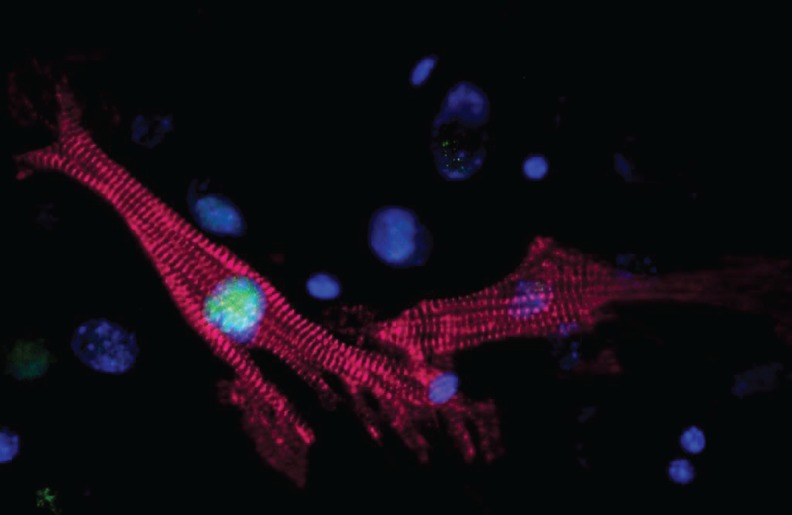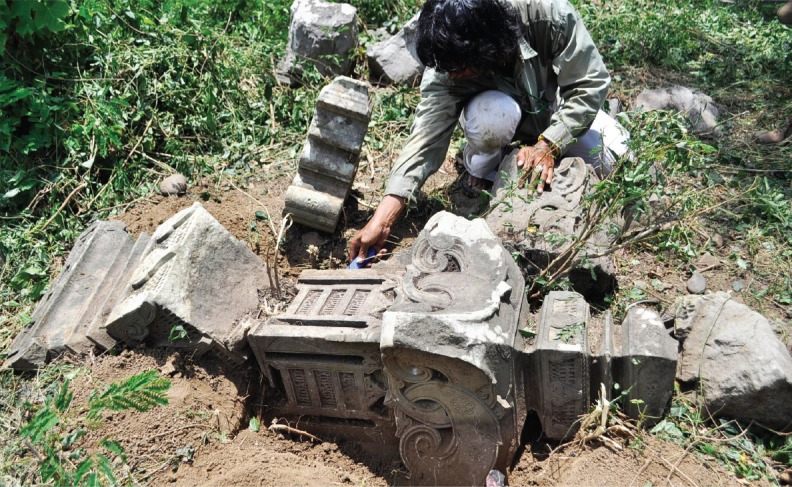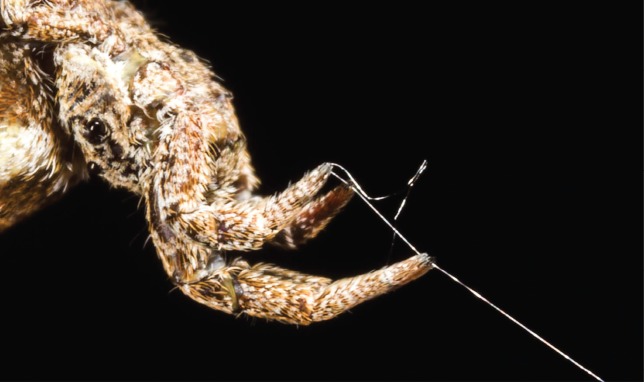Spider webs and power amplification
Hyptiotes holding trap line (connected to main web).
The human ability to use constructed devices such as catapults and ballistae to achieve power amplification in movement is considered unique. S. Han et al. (pp. 12060–12065) demonstrate how spider webs use power amplification to catch prey using energy stored in spider silk. The authors analyzed high-speed videos of triangle weaver spiders (Hyptiotes cavatus) and the spiders’ web kinematics while they hunted prey. The authors report that the spider stretches and tightens its web and holds the web under tension for hours. When prey comes in contact with the web, the spider releases its hold on an anchor line, causing the tension in the web to drive the spider forward at accelerations up to 772.85 m/s2. When the acceleration of the spider and web comes to a sudden stop, silk wraps around the prey from all directions. Compared to classical anatomical power amplification, using a constructed device such as a spider web offers many of the advantages of human tools, given that the webs are replaceable and allow spiders to subdue prey from afar, according to the authors. — M.S.
Effects of social disruption on killer whales
Group of killer whales surfacing in the offshore waters of the Crozet Islands surrounded by albatrosses and petrels.
Sociality among highly social top predators tends to enhance group member survival by enhancing fitness and foraging opportunities, but such social systems can be disrupted by catastrophic events. Marine Busson et al. (pp. 11812–11817) analyzed the social networks of 221 killer whales encountered on 6,087 occasions between 1987 and 2014 and assessed how severe mortality due to interactions with illegal fishing vessels between 1996 and 2002 affected killer whales of the Crozet Islands in years following the end of illegal fishing. The loss of individuals from a group resulted in weaker associations among surviving individuals, compared with associations detected from the preillegal fishing period. The authors also found a positive correlation between survival probability and social group size, although association strength was a stronger indicator of survival. Following the 7-year period of severe mortality, 98 individuals from social groups known prior to the illegal fishing period did not re associate in stable social groups. The whales’ survival rate declined, leading to a population decline from 98 individuals to 37 individuals. The findings suggest that the disruption of social groups caused by human-induced additive mortality events may result in long-term negative consequences, according to the authors. — M.S.
Cardiac regeneration by placental cells

Cardiomyocytes in culture that have differentiated from Cdx2 cells expressing green fluorescent protein in the nucleus. Cell nuclei are stained blue and α-sarcomeric actinin is stained cyan.
Adult mammalian heart tissue possesses limited capacity for regeneration following injury. Previous research has shown that certain fetal-derived cells, expressing the protein Cdx2, naturally migrate from the placenta to the injured maternal heart and form functional heart muscle cells, or cardiomyocytes. To evaluate the clinical potential of Cdx2 cells for heart repair, Sangeetha Vadakke-Madathil et al. (pp. 11786–11795) devised a method to label and track mouse fetal-derived Cdx2-expressing cells. These cells differentiated into beating cardiomyocytes, endothelial cells, or smooth muscle cells when cultured in the presence of other cardiomyocytes or cardiac fibroblasts. The Cdx2 cells expressed low levels of major histocompatibility complex molecules, suggesting that the cells could evade the host immune system, and expressed all of the proteins found in embryonic stem cells as well as a distinct set of proteins. When fetal-derived Cdx2 cells were injected into mice following a heart attack, the cells engrafted into the heart at and around the injury site and differentiated into mature cardiomyocytes and vascular cells, leading to improved cardiac function compared with controls. The results suggest that Cdx2 cells derived from placenta could form the basis of a cardiac repair therapy in humans, according to the authors. — B.D.
Technological shifts among early hominins

Sharp-edged tool from 2.6-million-year-old sediments in Ethiopia.
Evidence of production of flaked stone tools by hominins extends back 3.3 million years to before the emergence of the genus Homo, but the earliest known evidence of systematic production of such tools is dated to around 2.55 million years ago and comes from the Oldowan assemblages in Gona, Ethiopia. David Braun et al. (pp. 11712–11717) report the discovery of an additional Oldowan site designated BD 1, which extends the history of systematic tool-making to around 2.61 million years ago. The tools found at BD 1, although more primitive than those at other Oldowan sites, are technologically closer to those Oldowan tools than they are to the tools dating to around 3.3 million years or those produced by modern primates. Flake removal and tool-production technology may have yielded improved access to high-quality foods, and the expanded breadth of diet may have emerged around the same time as environmental changes in Ethiopia. Such changes in early human adaptation may have eased selective pressures on early Homo individuals. According to the authors, the distinctions between these earliest Oldowan assemblages and the industries recovered 3.3 million years ago suggests the possibility that stone tool production was reinvented multiple times in the past. — P.G.
Human circadian system and evening light

Evening light exposure affects circadian rhythm differently across individuals. Image courtesy of iStock/HAKINMHAN.
Exposure to light after dusk is pervasive in the modern world, representing a potential source of circadian rhythm disruption. Andrew Phillips et al. (pp. 12019–12024) report that humans are more sensitive to evening light than previously thought, and that there is a large difference in sensitivity across individuals. The authors exposed 55 healthy people, aged 18–30 years, to evening light for 5 hours. All participants were exposed to a baseline dim light (<1 lux) and light levels ranging from 10 to 2000 lux. On average, melatonin was 50% suppressed by exposure to 24.6 lux, which is comparable to or lower than typical indoor lighting used at night. At light levels as low as 6 lux in the most sensitive individual, 50% melatonin suppression occurred; however, 50% melatonin suppression occurred at 350 lux in the least sensitive individual. In addition, exposure to light intensities of 10 lux, 30 lux, and 50 lux delayed the rise in melatonin by 22 minutes, 77 minutes, and 109 minutes, respectively. According to the authors, individual differences in sensitivity to light may be an important and previously unappreciated determinant of the circadian clock’s role in human health and disease. — J.W.
Breast milk, bone growth, and childhood malnutrition
Undernutrition in children is a major global health problem that partly manifests as reduced growth, or stunting. Nutritional interventions aimed at treating stunting have been largely ineffective, highlighting the need for a greater understanding of the mechanisms that promote growth. Carrie Cowardin et al. (pp. 11988–11996) measured circulating biomarkers of bone resorption by osteoclasts and bone formation by osteoblasts in 54 stunted children with severe acute malnutrition and found evidence for elevated osteoclastic activity. Based on an earlier finding that some mothers of stunted children have reduced levels of sialylated breast milk oligosaccharides, the authors colonized young mice raised in a germ-free environment with a consortium of bacterial strains cultured from the gut microbial community of a severely stunted malnourished 6-month-old infant. Gnotobiotic mice exhibited decreased bone resorption when given a diet resembling that of the infant but supplemented with a purified bovine oligosaccharide mixture dominated by sialylated structures found in human breast milk. Supplementation decreased osteoclastogenesis while sparing osteoblast activity. Additional experiments found evidence that gut microbes, intestinal cell populations, and immune mediators were associated with the observed bone response. The findings suggest that interactions between milk oligosaccharides, the gut microbiota, and the immune system may uncover potential therapeutic targets for overcoming stunting in undernourished children, according to the authors. — J.W.
Ancient tsunami in Southeast Asia

Recording broken medieval carved stone grave marker.
Despite geological evidence that a tsunami hit the northern Sumatran coast in 1394 CE, little is known about how it affected coastal communities. Patrick Daly et al. (pp. 11679–11686) found archaeological evidence of a 14th century tsunami that destroyed nine low-lying coastal settlements in the same areas destroyed by the 2004 Indian Ocean tsunami. Only a settlement located on an elevated headland survived. Analysis of imported trade ceramics from Burma, China, Thailand, and Vietnam suggested that there was a major shift in the political economy of the region in the century following the disaster, from the headland site to the repopulated lowland settlements. Analysis of gravestones and ceramic sherds suggested an influx of traders from around the straits of Melaka into areas destroyed by the tsunami. In the early 16th century, these low-lying settlements formed the foundation of the Aceh Sultanate. The capital of the Aceh Sultanate became the modern city of Banda Aceh, where more than 150,000 people were killed by the 2004 Indian Ocean tsunami. Similar to the past, coastal areas have been repopulated, raising the likelihood of future large-scale disasters, according to the authors. — M.S.




